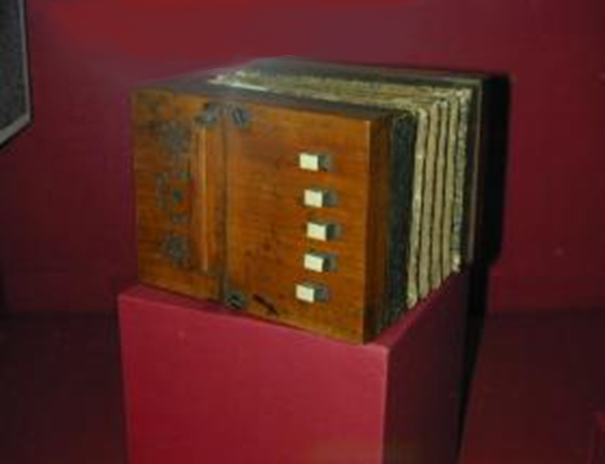From stocking maker to instrument maker of an “Accordion of a new kind”

Carl Friedrich Uhlig was born in Bernsdorf near Chemnitz in April 1789 and was a trained hosier.
Uhlig played the clarinet in a Chemnitz orchestra. In 1819, he took a new direction and founded a music shop. He ran his business at the address “Anger 902” (today approximately “Brückenstraße 10”).
In 1834, Carl Friedrich Uhlig constructed a small concertina with alternating tones and presented it in the Chemnitzer Anzeiger as his “Accordion of a new kind”. He had probably acquired the knowledge for this in Viennese harmonica workshops. (Source: Maria Dunkel: “Akkordeon – Bandonion-Concertina”. p. 21)
An advertisement from 19 July 1834 in the Chemnitzer Anzeiger states: “The store of musical instruments is highly recommended with a nice selection…large and small violins, guitars…accordions of a new kind along with a lesson and the cheapest prices. My stand at this forthcoming market will be in Mr Weigel’s house on the market square. Carl Friedrich Uhlig „Am Anger Nr. 902“
Uhlig did not yet have a new name for this “accordion of a new kind”; he modelled the name on the accordion of the Viennese organ and piano builder Cyrill Demian, who acquired a patent for a new instrument in 1829. The name accordion came to designate all instruments in which either a piano key or a button is underlaid with a chord. However, Uhlig’s instrument was not an accordion as we know it today, as the buttons on his instrument are not underlaid with chords, but with single notes.
In the same year as Demian, the English physicist Charles Wheatstone was granted a patent for a harmonica, which was later known as the English concertina. (Source: Kurt Kauert: “Der Musikwinkel und die Harmonika“, p.17)
The development took place at the same time; Uhlig probably knew nothing of the English concertina at first. Although Uhlig’s instrument was later called the concertina, it has little to do with the English concertina. Unlike Uhlig’s instrument with a square box, the English concertina does not have alternating tones, but is of the same tone, whether you pull up or press the bellows, and has an hexagonal shape. To differentiate between the two, Uhlig’s instrument was later called the German concertina or the Chemnitz concertina.
Uhlig’s “Accordion of a new kind” – later called the Chemnitz Concertina – was a small alternating-tone instrument with 5 buttons each to be played with the right and left hand. As this alternating tone instrument produces two different tones when the bellows are pulled up and pressed together, it had a range of 20 tones. All concertinas, like the bandonions, have no ready-made chords, they are monophonic. For this reason, they are far superior to instruments with prefabricated chords in terms of harmonic possibilities and voice leading. (Source: Karl Oriwol: “Das Bandonion.”)
A description of this instrument, i.e. that it is a single-tone instrument, can be found in what is probably the earliest school for the German concertina, an anonymous “Anweisung das Accordion zu spielen” (Instructions on how to play the accordion), which was published by Johann Gottlob Höselbarth in Chemnitz. It possibly originated from Uhlig’s son-in-law Johann David Wünsch, who later wrote in the Leipziger Tageblatt “…at the beginning of the 1930s C.F. Uhlig built the first square harmonica in Chemnitz. Each side had 5 buttons, each button 2 notes… In 1836 the instrument was perfected by adding 5 more buttons to each side… For this two-row instrument the first schools were also published by me… In 1840 we began to build three-row instruments with 56 notes, tuned in G, A and E major…”
Unfortunately, no surviving concertina with 10 buttons that can be attributed to Uhlig is known to experts. On the occasion of the 2001 special exhibition “Sehnsucht nach dem Blasebalg” (Longing for the Bellows), one of the oldest concertinas made in Chemnitz was presented in the Chemnitz Schlossberg Museum. This instrument was signed “Pirner”. Christian Friedrich Pirner ran a concertina production facility in Mühlenstraße between 1850 and 1860, although it is not clear whether he worked for the forefather of the Chemnitz concertina, Uhlig, or was a competitor.
This instrument was on loan from a private collector in Dublin.

From an advert in the Chemnitzer Anzeiger in 1838, it can also be safely concluded that these “new accordions” came from Uhlig’s own manufactory. However, the address of Uhlig’s main production site in 1838 was no longer Anger, but Brückenstraße, house number 902. From 1840, the address of the unchanged location was “Untere Brückenstraße 4”. It is certain that many parts were manufactured in home industry and finally assembled in Uhlig’s company. Despite attempts to keep production details secret, competitors in Chemnitz and the region opened their own production facilities.
From 1847, C.F. Uhlig was regularly represented with his instruments at the Leipzig Trade Fair. Uhlig’s Concertina was honoured with a medal of honour at the General Industrial Exhibition in Munich in 1854.
The production of concertinas soon expanded beyond the city limits of Chemnitz, as his innovation spread as far as the Erzgebirge, the Vogtland music region and Waldheim.